Kristine Hughes's Blog, page 139
September 20, 2011
400th Anniversary of the King James Bible and Hatfield House
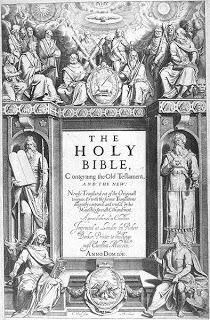
The year 2011 marks 400 years since the Bible was translated into the English language in the Authorized Version, aka the King James Bible. After a labor of more than seven years by 47 or more scholars, this third version in English was printed and has, ever since, been one of the most influential books in the English speaking world.
So, friends, eat drink and be merry, for in the fullness of time, you may have to become my brother's keeper, for he fell flat on his face, though he is clearly the salt of the earth and only occasionally acts holier than thou. He is as old as the hills, but has had his fall from grace due to his feet of clay and his taste for forbidden fruit. In the twinkling of an eye, the powers that be could reach the root of the matter. As we sometimes say, the spirit is willing but the flesh is weak. So will you cast the first stone? Be a fly in the ointment? Or will you gird your loins, put your house in order and find your heart's desire? Remember, we reap what we sow.
Okay, so that paragraph is a bit lame, but it illustrates how many familiar phrases -- cliches really -- come from the KJV.
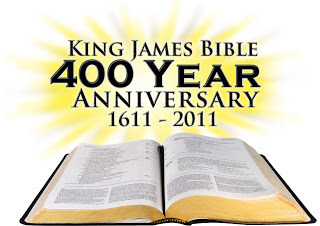
Numerous celebrations, conferences, services, choral events and exhibitions have been going on all year. For upcoming events and more information, click here for the King James Bible Trust website with further information. Of special interest is the website's video on life in 1611.
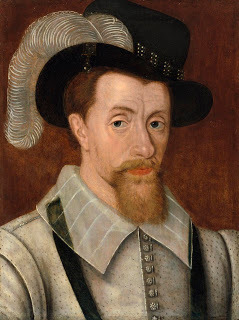 King James
King JamesImages courtesy of King James Bible Online; for more, click here.
Many of the stories about the anniversary mention the coincidence of this Bible being written at roughly the same time Shakespeare's works were performed and published. William Shakespeare (1564-1616), the English language's most famous poet and playwright, must have known and seen the new bible. I wish I could find out what his reaction was, but so far I haven't found any comments from Will.
 The Chandos Portrait of Shakespeare, National Portrait Gallery
The Chandos Portrait of Shakespeare, National Portrait GalleryThe period of the English Renaissance which brought us both the King James Bible and Shakespeare was part of great changes in all aspects of life. But even today, we recognize the timelessness of these great works. And celebrate them!
Another 400th anniversary marked in 2011 is for Hatfield House in Hertfordshire, home of the Marquess of Salisbury. Here is their website. And for my blog post on a Hatfield visit in 2010, see 8/13/10. I visited again last June (2011) and took a few more pictures.
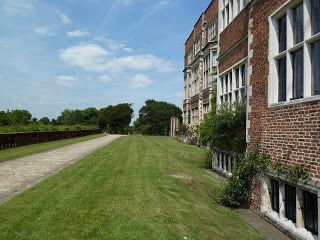
Above is a shot I took from the staff and business entrance to the House, which is a big working enterprise. I was there to do some research in the Archive.
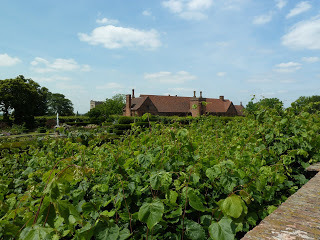 From near the same spot, one can gaze across the gardens to the Old Palace, where Elizabeth I lived as a child and young woman. Just to the left of the Palace roof is the tower of the parish church, St. Etheldreda's.
From near the same spot, one can gaze across the gardens to the Old Palace, where Elizabeth I lived as a child and young woman. Just to the left of the Palace roof is the tower of the parish church, St. Etheldreda's.Below, the church in 2009. Here is their website.
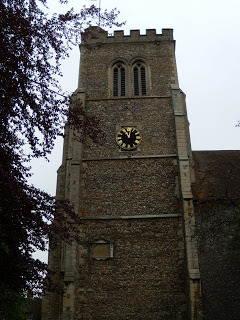
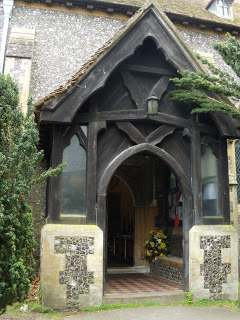
Below, one of the handsome lamps that grace the park.
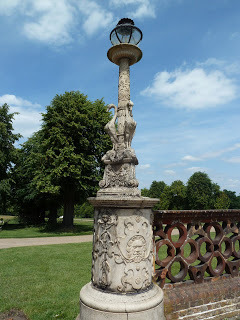
And finally, some of Lady Salisbury's beautiful old roses.
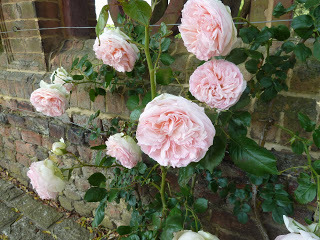
2011 is a good year in many ways -- and so apparently was 1611.
Published on September 20, 2011 02:00
September 18, 2011
Moats, Five of 6,000
Victoria here. The Summer 2011 issue of the National Trust Magazine has a page of facts and figures with several fun items:43 is the number of pubs owned by the NT; 200 bicycles are available to hire in Cumber Park Nottinghamshire; and 6,000 is the number of MOATS in the UK, "making them one of our nation's most common medieval monuments."
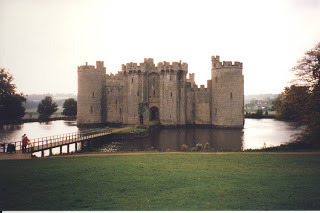
Bodiam Castle
I went to my picture collection to see how many moats I could account for. A recent one, though now a dry garden, was at Walmer Castle in Kent, which you can read about on this blog of 7/24/11.
Perhaps my favorite is the moat at Scotney Castle, also in Kent. The website is here.
Be sure to click on the photo gallery for lovely pictures, though none quite so atmospheric as the ones I took on a visit in late October mist. The gardens have been planted for special beauty in the spring and autumn.
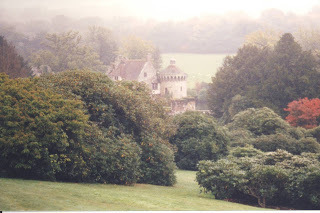 In the 19th century, the gardens were designed in the picturesque manner by William Sawrey Gilpin for the Hussey family; Gilpin's uncle, the Rev. William Gilpin, had criticized the style of his contemporary Capability Brown as too smooth and tame.
In the 19th century, the gardens were designed in the picturesque manner by William Sawrey Gilpin for the Hussey family; Gilpin's uncle, the Rev. William Gilpin, had criticized the style of his contemporary Capability Brown as too smooth and tame.
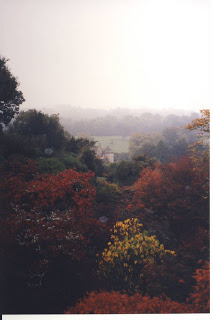 The old castle, dating from the 14th century, was "selectively ruined" to provide a focal point for the garden, leaving only one round tower of the original four.
The old castle, dating from the 14th century, was "selectively ruined" to provide a focal point for the garden, leaving only one round tower of the original four.
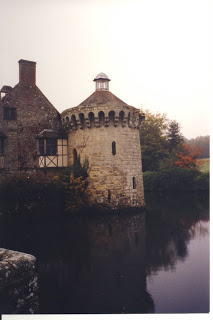
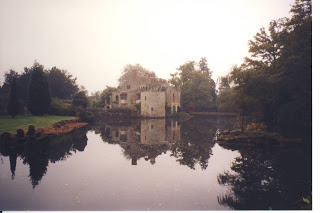 In 1970, the garden was left to the National Trust. The moat acts as a perfect mirror in the above romantic view. In one of my several visits to Bodiam Castle in East Sussex, it was January and the moat was frozen.
In 1970, the garden was left to the National Trust. The moat acts as a perfect mirror in the above romantic view. In one of my several visits to Bodiam Castle in East Sussex, it was January and the moat was frozen.
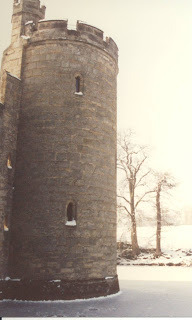
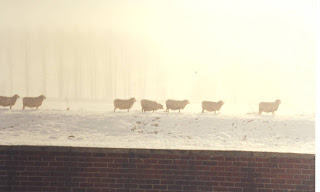 After a snowstorm, the site was deserted, silent and ghostly in the fog, shared only with the sheep who were bundled up against the wind in their finest fleece. My husband and I made our lonely way around the ruins, reading all the labels and trying to imagine how it would have looked when it was the lively center of a great community.
After a snowstorm, the site was deserted, silent and ghostly in the fog, shared only with the sheep who were bundled up against the wind in their finest fleece. My husband and I made our lonely way around the ruins, reading all the labels and trying to imagine how it would have looked when it was the lively center of a great community.
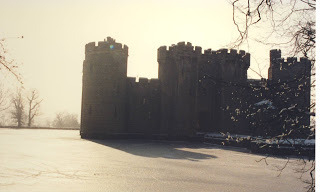
Another visit was in October, in bright sunshine. There were many more visitors, although I managed to take my snaps in between them!
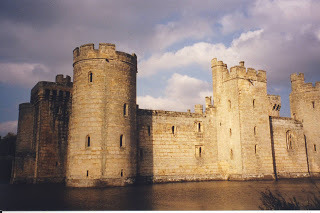
Bodiam Castle was constructed in the late 14th century and though ruined during the Civil War when attacked by Parliamentary forces who eventually removed its roofs, it is relatively intact. George Curzon, 1st Marquess Curzon (1859-1925), purchased Bodiam in 1916 and managed a number of preservation and restoration projects there before presenting it to the National Trust in 1925, which has continued to protect the popular site.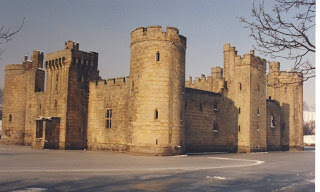
The sheep were happier, it seemed, but you will note they had a good October start on their winter coats.
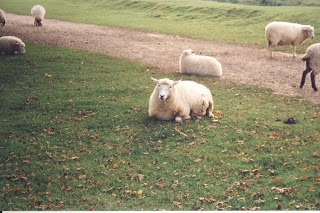
Bodiam was used as the Exterior of Jane Austen's Northanger Abbey
in the 1986 BBC version, even though it was never an abbey nor does it resemble the Northanger Austen describes. Bodiam has also appeared in episodes of Dr. Who and Monty Python and the Holy Grail, among many other films and tv programs.
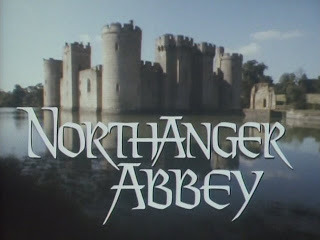
Both Bodiam and Scotney are NT sites easily accessible from London. Two other popular tourist sites with lovely moats are Leeds Castle and Hever Castle, also not far from the City.
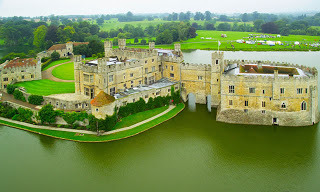
Leeds Castle, Kent
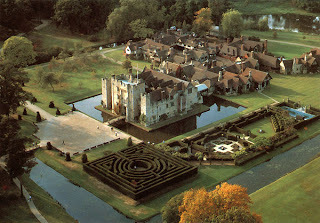 Hever Castle
Hever Castle
Apparently I have more than 5,995 more moats to discover ... where do I start? Do you have a favorite moat?

Bodiam Castle
I went to my picture collection to see how many moats I could account for. A recent one, though now a dry garden, was at Walmer Castle in Kent, which you can read about on this blog of 7/24/11.
Perhaps my favorite is the moat at Scotney Castle, also in Kent. The website is here.
Be sure to click on the photo gallery for lovely pictures, though none quite so atmospheric as the ones I took on a visit in late October mist. The gardens have been planted for special beauty in the spring and autumn.
 In the 19th century, the gardens were designed in the picturesque manner by William Sawrey Gilpin for the Hussey family; Gilpin's uncle, the Rev. William Gilpin, had criticized the style of his contemporary Capability Brown as too smooth and tame.
In the 19th century, the gardens were designed in the picturesque manner by William Sawrey Gilpin for the Hussey family; Gilpin's uncle, the Rev. William Gilpin, had criticized the style of his contemporary Capability Brown as too smooth and tame.
 The old castle, dating from the 14th century, was "selectively ruined" to provide a focal point for the garden, leaving only one round tower of the original four.
The old castle, dating from the 14th century, was "selectively ruined" to provide a focal point for the garden, leaving only one round tower of the original four.

 In 1970, the garden was left to the National Trust. The moat acts as a perfect mirror in the above romantic view. In one of my several visits to Bodiam Castle in East Sussex, it was January and the moat was frozen.
In 1970, the garden was left to the National Trust. The moat acts as a perfect mirror in the above romantic view. In one of my several visits to Bodiam Castle in East Sussex, it was January and the moat was frozen.
 After a snowstorm, the site was deserted, silent and ghostly in the fog, shared only with the sheep who were bundled up against the wind in their finest fleece. My husband and I made our lonely way around the ruins, reading all the labels and trying to imagine how it would have looked when it was the lively center of a great community.
After a snowstorm, the site was deserted, silent and ghostly in the fog, shared only with the sheep who were bundled up against the wind in their finest fleece. My husband and I made our lonely way around the ruins, reading all the labels and trying to imagine how it would have looked when it was the lively center of a great community. 
Another visit was in October, in bright sunshine. There were many more visitors, although I managed to take my snaps in between them!

Bodiam Castle was constructed in the late 14th century and though ruined during the Civil War when attacked by Parliamentary forces who eventually removed its roofs, it is relatively intact. George Curzon, 1st Marquess Curzon (1859-1925), purchased Bodiam in 1916 and managed a number of preservation and restoration projects there before presenting it to the National Trust in 1925, which has continued to protect the popular site.

The sheep were happier, it seemed, but you will note they had a good October start on their winter coats.

Bodiam was used as the Exterior of Jane Austen's Northanger Abbey
in the 1986 BBC version, even though it was never an abbey nor does it resemble the Northanger Austen describes. Bodiam has also appeared in episodes of Dr. Who and Monty Python and the Holy Grail, among many other films and tv programs.

Both Bodiam and Scotney are NT sites easily accessible from London. Two other popular tourist sites with lovely moats are Leeds Castle and Hever Castle, also not far from the City.

Leeds Castle, Kent
 Hever Castle
Hever CastleApparently I have more than 5,995 more moats to discover ... where do I start? Do you have a favorite moat?
Published on September 18, 2011 02:00
September 16, 2011
The Cavalry Horse
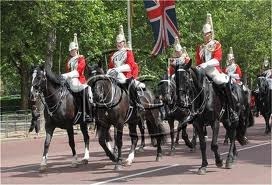
From The Horse-World of London by William John Gordon (1893)
There is no more eloquent testimony to the orderliness of London than the mere sprinkling of cavalry within its limits. It may seem ridiculous to the foreigner that with 375 mounted police, and two small regiments of Household troops numbering 275 horses each, five millions of people are content to behave themselves; but it is a state of affairs of which Englishmen have no cause to be ashamed. Even adding in the six battalions of Foot Guards and the line battalion at the Tower, and considering that there is Woolwich, and that there are Hounslow and Windsor not far off, and that there are facilities of communication—not, however, greater than exist in other capitals—we shall find that the police, and military ready to be used as police, in and about London, are a mere handful compared to what are necessary for peace-keeping and ceremonial purposes in the cities across the Channel.
At one time the black horses of the Household cavalry came almost entirely from Yorkshire and North Lincolnshire, most of them being expressly bred for the service. But of late we have changed all that. In those days the cavalry colonels had so much money allowed them for remounts, and they had to pick up their horses where they could, with the jobmaster at their elbow—for a consideration—to help them at a pinch; and some of the London jobmasters had a standing order to be on the look-out for likely horses for certain regiments. Nowadays the Dublin dealer has taken the place of the London man, and, instead of the colonel buying horses, the buying is done by the Remount Department, whose happy hunting ground is Ireland.
When a military horse is 'cast,' and all military horses are 'cast' at fourteen years old, whether they be good, bad, or indifferent, a requisition for a substitute goes to the Remount Department at Woolwich, and the substitute arrives a day or two afterwards from the Emerald Isle, generally shipped direct by Daly or some other Dublin dealer. That the new horse is as good to look at as the old Yorkshire one, we have not heard any soldier declare, but he is at least thirty per cent. cheaper, and he seems to be strong enough for his work.
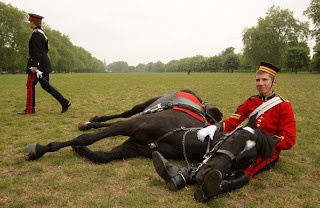
A British army corps, when discoverable, will be found to have 12,000 horses, of which 3,134 will be in the cavalry and 2,987 in the artillery; these 6,121 horses ought to be thoroughly broken and trained, even if the remainder are not. There are said to be only 70,000 horses in the British Isles fit for army work, but this is one of those pleasant fictions of which it is When Napoleon attempted to invade us—an attempt that was defeated at Trafalgar, which to the uninitiated may seem to be a long way off for the defeat of such a scheme, although any future attempt will probably have to be reckoned with still farther at sea—the Government took stock of every horse in the kingdom, with the intention of a general impressment for military service; and nowadays the Government has power in times of national peril to lay hands on every horse within these islands, in preparation for which there are thousands of horses under subsidy with a view to immediate use. And when this seizure does take place, it will certainly not be to the joy of the jobmaster; he above all men shudders at the mere mention of foreign invasion, for invasion to him means the entire loss of his means of livelihood, and this at a sacrifice, for no Government would pay the price at which the jobmaster's stud has been collected.
The Life Guardsman's horse used to cost 601., being the most expensive horse in the army; we shall not put him offensively cheap in these times at 201. less; nor shall we be divulging any secrets of state in estimating that the cost of mounting the two regiments of cavalry in London—barring the officers' chargers—does not exceed 22,000L
And yet the horses are carefully chosen and seem fit for their work, when either in or out of harness. They, of course, look their best at Knightsbridge, for at Knightsbridge the stabling is distinctly good, better even than is promised in the new barracks in Albany Street; but then a soldier's horse in stable generally looks better than a civilian's, owing to his head being where his tail should be. The civilian's horse always has his head over the manger; the soldier's horse is turned round as soon as he has finished his feed, and so gets more fresh air; the consequence of which admirable arrangement for preventing a horse ' breathing his own breath,' is that the visitor on entering the stable sees a double line of intelligent heads, .instead of an avenue of hocks and tails.
Time was when every soldier's horse had a name, the initial of which was that of the troop to which he belonged. 'A' troop had all A's, ' B' had all B's, and so on; but in these days the squadron is the unit, not the troop, and the name has given place to the number. Every horse, then, has his number placed on a card over his manger, and the horses are separated from each other by a pole doing duty as a bale, and on each upright is the horse's kit, including the two spare shoes which every trooper carries, but not including the arms, which, of course, are kept elsewhere. This kit, and the arms and the rider, make up a nice little load, which averages out at twenty-three stone per man; not quite so heavy as that of our fat old knights, but still heavy enough for the class of horse which has nothing of the 'dray' type about it.
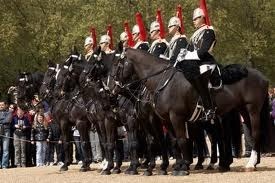
It is not easy to get these horses of uniform type and character. There are many exchanges and rejections, and it often happens that a horse sent in for cavalry work has to go to the draught, to the Artillery, or even the Transport service; so that though the remainder may not be examples of the much-talked-of survival of the fittest, they are at least representative of the not unfit. They are smart, workmanlike horses. It is absolutely necessary that a regiment should be as sound in its horseflesh as in its men. Theoretically no remounts are accepted that are not looked over on level ground, on a road, or in a large* yard, for it is easy to pass a bad horse in a field, or on a hillside, or in deep pasture, or when under cover, or in a drove. It is not safe to choose an underbred animal, immediately conspicuous by his coarse head, or thick throat, or short neck, or large, bony joints, or clumsy legs, or short pasterns, or curly in the hair of his mane or tail. The typical cavalry horse must have a small lean head, a flat, broad forehead, fine, full nostrils, a good, clean throat, thin neck, well-shaped legs, long pasterns, and straight hair, with a deep, wide chest, and short, broad back and loin. No long backs will do, for long backs do not carry weight, and short necks or croups are simply impossible for soldiering. Of course the horse has to be of the regimental colour. In the cavalry generally chestnuts are not in favour, for chestnuts usually have white, and white, except in the Scots Greys, is not desirable; neither chestnuts then, nor mealy bays, are fit for cavalry work, but roans and bays and browns, and for our Guardsmen blacks.
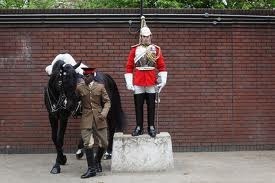
These are bought when rising four years old, and require about six months' training by the rough riders before they can be passed out of the riding school as efficient by the colonel. The Knightsbridge riding school is about forty-five yards long by sixteen wide, and in it perhaps fourteen young horses at a time will be at work, though the number of course depends on what the horses have to do. Their training is not as simple as might at first appear. The soldier has only one hand to work his horse with, and what an ordinary rider would do with the other hand he has to do with his leg. How skilfully he manages to guide by leg pressure is known to those who have seen the Musical Ride at the annual Military Tournament, which is little more than the ordinary practice of the riding school. But it should not be forgotten that the horse has to be taught to understand this pressure, and that his training is almost as long a business as that of his rider.
Very early in the morning, so as not to alarm the passers-by, the young horse is taught to stand fire by having a gun discharged close to him, and being encouraged to smell the powder and the smoking weapon; he thus becomes familiar with the sound and scent, much as a boy does, though there is nothing to show that he ever associates the idea of being shot with the report which he soon treats with indifference. When once he is trained his work becomes lighter, and he cannot be said to have a hard life in London, an occasional outing at Wimbledon being his severest trial. Being condemned at fourteen, his full service is a little over ten years; but it is rare that he reaches the limit, and his average military life is between six and seven. When it is over he goes back to the depot, and thence he often comes again by way of the sale yard into the London crowd.
Published on September 16, 2011 00:20
September 14, 2011
Death of Wellington at Walmer
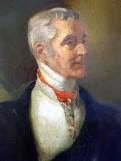
From The History of Walmer and Walmer Castle by Charles Robert Stebbing Elvin (1894)The Duke of Wellington was Lord Warden for nearly four and twenty years, and during all that time rarely missed coming to Walmer after the prorogation of Parliament, staying usually till about the middle of November; and, before leaving for Strathfieldsaye, generally held at Dover a Court of Lodemanage, to discuss and settle the affairs of the Cinque Ports' pilots.For some years before his death, the Duke had been in failing health. Seated in the drawing-room in his favourite armchair, he would often, after dinner, take a newspaper in one hand and a candle in the other, and fall asleep while reading in this dangerous position, to the great anxiety of his friend and companion, Mr. Arbuthnot. The end came suddenly at last. The Duke was accustomed to rise early, but, on September 14th, 1852, when his valet called him as usual at six o'clock, he found the Duke particularly drowsy, and thought it best to leave him undisturbed for an hour longer. He therefore withdrew, but remained within hearing. It was fortunate he did so, for soon after he was alarmed at hearing groans from the Duke's room, and on re-entering was requested to send for Dr. Hulke of Deal, who came, prescribed some simple remedies, and, seeing nothing serious in the Duke's condition, departed. Shortly after this, however, the Duke became much worse, and messages were despatched for further help. On the return of Dr. Hulke with his son and Dr. McArthur, they found his Grace breathing laboriously, unconscious, and very restless. To assist respiration he was raised and put into his easy chair, where for a time he breathed more freely; but the end was very near, and at five and twenty minutes past three he expired. A message had meanwhile been sent to London for Dr. Williams, who only arrived in time to find the mortal remains of his illustrious patient laid out upon his little camp-bed.
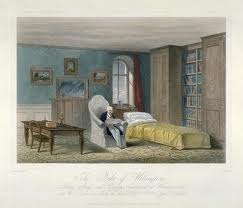
The Union Jack now drooped at half-mast high upon the castle ramparts; announcing to the world that the Iron Duke, the nation's idol was no more. The body of the departed hero remained at Walmer Castle until the eleventh of November, in the irregularly-shaped room shown in the engraving; which still retains the name of "The Duke's Room." The scene at Walmer, subsequent to the removal, cannot be better described than in the following extract from a contemporary record, which conveys a most graphic idea of all the solemn proceedings of this time :—" In the small irregularly shaped death-chamber lay the body of the Duke, inclosed in an outer coffin covered with crimson velvet, and with handles and funeral decorations richly gilt. On the lid, near the head, rested the ducal coronet, and beyond it the pall, gathered back, to give visitors a complete view. The coffin rested on a low stand, covered with black cloth, round which candelabra with huge wax lights and plumes of feathers were arranged. The walls and roof of the small apartment were, of course, hung with black cloth, the single deep-recessed window closed, and candles, reflected against silver sconces, barely relieved the gloom of the sombre display. Visitors entering at one door passed by the end of the coffin, and then out at another without interruption. The ante-chambers and corriders were also darkened, hung with black, and lighted with candles placed at intervals on the side walls."The first day for admission of the public was Tuesday (Nov. 9th). Through the low strong archway of the entrance the visitors passed, first, along the curved glass-covered passage, then through the dimly lighted anterooms into the chamber of death, and then along corridors and down staircases and across the garden on to the beach. All the way at a few paces distance from each other on either hand, the guard of honour of the Rifle Brigade were placed, each man with his arms reversed, and leaning in a sorrowful attitude on his musket. Along the beach, as far as the eye could reach towards Deal, a long train of visitors dressed in mourning passed and repassed throughout the day, while from greater distances conveyances arrived and took their departure in quick succession."
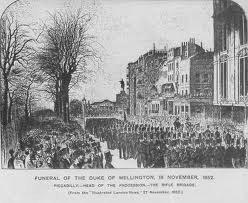
The stream of visitors continued throughout the Tuesday, and until four o'clock in the afternoon of the following day; during which time upwards of nine thousand people are said to have visited the chamber of the late Duke to witness the lying in state. But about 7 p.m. on Wednesday (Nov. 10th), the body was removed to Deal Station, en route for London, under an escort of about 150 men of the Rifle Brigade, commanded by Colonel Beckwith, and attended by mourning coaches in which were seated the Duke's eldest son and successor, Lord Arthur Hay, Captain Watts, Mr. Marsh of the Lord Chamberlain's office, and others.
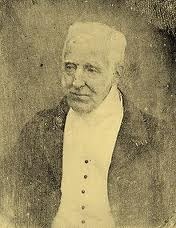
The Duke of Wellington
As the funeral cortege prepared to leave the grounds, the solemn booming of the minute-guns resounded from the castle walls; while the wind brought back the echo from Deal and Sandown, where the like honour was paid to the memory of the deceased. Down the "sombre avenue," lighted by the lurid glare from the flambeaux with which a body of men led the way, and through the silent crowds who lined the road undeterred by chill darkness of a November night, winded the slow procession; moving with measured tread, until at length they reached Deal Station; the melancholy march of a mile and three-quarters having occupied no less than one hour and a half. There they were awaited by Mr. James Macgregor, M.P., the chairman of the South-Eastern Railway Company; and the hearse having been transferred to a truck, the journey onward to London was resumed at a quarter past nine.
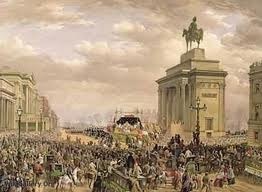
"Funeral of the Duke of Wellington the funeral car passing the archway at Apsley House"
On arriving at the Bricklayers' Arms station, the hearse with the coffin was removed to Chelsea Hospital, under an escort of the 1st Life Guards; and there the remains of the Duke continued to lie in state till removed for the Grand State Funeral which took place on the following Thursday, November 18th.
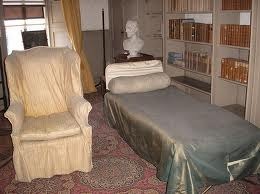
In 1861, shortly after the appointment of Lord Palmerston (as Lord of the Cinque Ports), several articles were removed from (the Duke of Wellington's room at Walmer) to Apsley House, with the consent of Lord Dalhousie's executors, in consequence of a threatened sale by auction; but these have all been recently restored, through the generosity of the present Duke of Wellington, as related further on; and "The Duke's Room" is once again as it used to be, even to the yellow moreen curtains and the orignal bedding and chair-cover. The bookshelves have, however, been wisely covered with glass doors, and so converted into a cabinet, in which many articles of interest are kept under lock and key; including the Duke's set of his own printed despatches, in twelve vols., the first volume of which has been despoiled of its title-page by some thief, or thievish collector, for the sake no doubt of the autograph. This cabinet also contains, among other things, two pairs of "Wellington" boots, and a volume of Statutes relating to the Cinque Ports, of the date of 1726. The latter was presented to the Duke of Wellington by Lord Mahon, and contains the autograph of each. One pair of the "Wellingtons," described in the schedule of heirlooms as a pair of "Field Marshall's 'Wellington' boots," are believed to be the same that were worn by the Duke at the Battle of Waterloo. The famous camp-bedstead has now a green velvet coverlet, presented by the Countess of Derby in 1893.
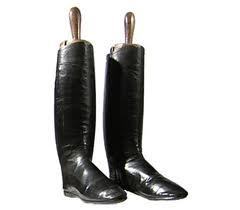
The engravings in this room include portraits of Mrs. Siddons, Mr. Burke, and Lord Onslow, as well as the Duke's print of the Chelsea pensioners reading the Gazette announcing the victory at Waterloo; and in the adjoining dressing-room, is a curious piece of work, made by the Duke's house carpenter and shown at the Exhibition in 1851, being the representation of Strathfieldsaye House, in the form of a picture, composed it is said of 3,500 pieces of wood. The Duke of Wellington thought so much of this picture that it used to hang during his lifetime in the dining-room.
Published on September 14, 2011 00:57
September 12, 2011
Things We Covet
The new auction catalogue is available from Dominic Winter Book Auctions, who happen to offer alot more than antiquarian books and maps, as will be seen by the selections below, any and all of which Victoria and I would give our eye teeth to own. From their auction on Wednesday 21 September 2011 commencing at 11.00 a.m., a private collection of antique fans is on offer in Lots 257 to 325. Here are a few examples -
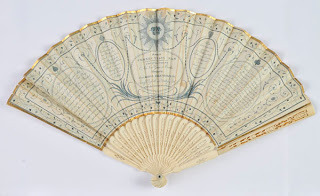
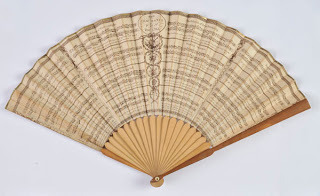
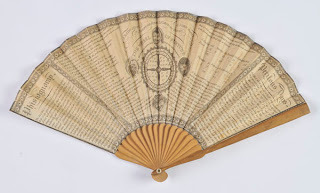
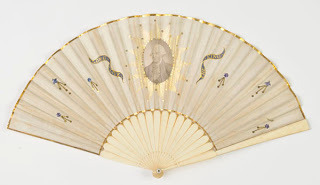
You can find, and drool over, all fans on offer here.




You can find, and drool over, all fans on offer here.
Published on September 12, 2011 23:44
The Crying Duchess
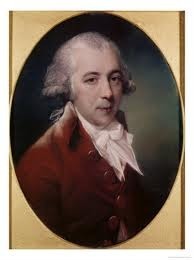
Richard Brinsley Sheridan
Mrs. Creevey to (her daughter) Miss Ord.
12 Sept., 1806."... I am going to Somerset House to enquire after poor Sheridan, who went from this house very ill at 12 o'clock last night. . . . He complained of sore throat and shivering, and his pulse was the most frightful one I ever felt; it was so tumultuous and so strong that when one touched it, it seemed not only to shake his arm, but his whole frame. ... I lighted a fire and a great many candles, and Mr. Creevey, who was luckily just come home from Petty's, began to tell him stories. . . . Then we sent for some wine, of which he was so frightened it required persuasion to make him drink six small glasses, of which the effect was immediate in making him not only happier, but composing his pulse. ... In the midst of his dismals he said most clever, funny things, and at last got to describing Mr. Hare, and others of his old associates, with the hand of a real master, and made one lament that such extraordinary talents should have such numerous alloys. He received a note from Lady Elizabeth Forster, with a good account of Mr. Fox. It ended with—'try to drink less and speak the truth.' He was very funny about it and said: 'By G-d! I speak more truth than she does, however.' Then he told us how she had cried to him the night before, 'because she felt it her severe duty to be Duchess of Devonshire!' *
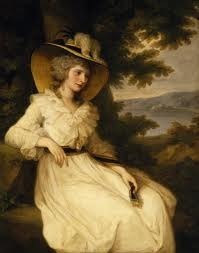
Lady Elizabeth Foster by Angelica Kaufman
* Georgina, the Duchess of Devonshire, had died in March of this year. Lady Elizabeth married the Duke, but not till three years later, in 1809.
Published on September 12, 2011 00:53
September 10, 2011
Visiting the Geffreye Museum by Guest Blogger Jo Manning
THE GEFFRYE MUSEUM, HISTORIC ALMSHOUSES * ON KINGSLAND ROAD, SHOREDITCH, A GEM IN THE HEART OF LONDON'S EAST END!
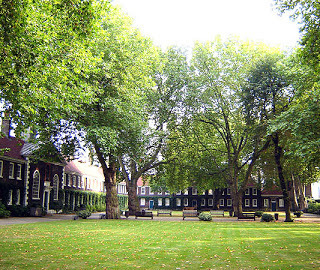 Geffrye Museum frontage, showing extensive lawns…a serene place of an afternoon to wander about or just to sit on a bench and contemplate life…
Geffrye Museum frontage, showing extensive lawns…a serene place of an afternoon to wander about or just to sit on a bench and contemplate life…
Blogger Margarita Lorenzo (her blog is here) writes:
"13 years I have been in London, and never have visited the Geffrye Museum before, that is bad!! considering it is a bus ride away from home, free to visit and about a subject I adore, interiors. [I] decided to venture to East London to discover a bit more about this area and the Museum. The venue is the right size, have gorgeous gardens, entrance, and rooms exploring each period of the English Middle Class houses and their decorations, different styles, ways of living etc. … "
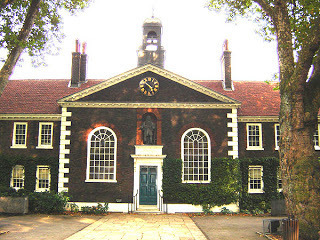 Main entrance to Geffrey Museum, with statue of Sir Robert Geffrye, who was a Lord Mayor of London and Master of the Ironmongers Company, over the door
Main entrance to Geffrey Museum, with statue of Sir Robert Geffrye, who was a Lord Mayor of London and Master of the Ironmongers Company, over the door
Ms. Lorenzo's remarks are what one hears over and over again when the Geffrye Museum is mentioned in conversation… Yes, people have heard the name, but, no, they've never visited, and, gee, it's so accessible using public transportation!
And the exhibitions are always worthwhile. In keeping with the dedicated educational purpose of the Geffrye, there are excellent demonstrations and talks. Their holiday celebrations are not to be missed! (Though be warned that the herb gardens may not be open to the public at that time.) Click here for upcoming events.
So, yes, if one has the time, walk…but take a good map. There are some challenging blocks from the tube station to the Geffrye, many windings and turnings. (And some excellent Vietnamese restaurants, though I'd recommend eating in the brand-new, very nice restaurant at the Geffrye.) This used to be the seat of the furniture trade and a Jewish area. It was also home to Huguenot weavers. The little houses where the weavers lived and wove are now selling in the millions of pounds.
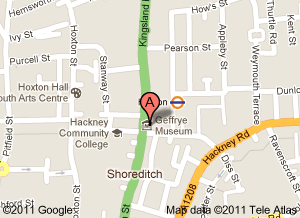
Before lottery money, the Geffrye was these old almshouses bequeathed by a wealthy 17th century London merchant, a charming but rather modest low-key and free museum that was a must on school visit lists. Its raison d'etre was the glimpse of the many rooms, by century and decade, depicting life in London. Since my initial visit some dozen or so years ago, the Geffrye has blossomed. Yes, that lottery money! It enabled the museum to put in more extensive herb gardens (a joy!), expand the educational nature of the museum with gallery space and a large room for crafts and other activities, add additional period rooms, exhibition space, and, last though certainly not least, to install a gorgeous restaurant where once there was only a modest café.
(See wwww.geffryemuseum.org.uk for a virtual tour, or, using the search term Geffryre Museum, click on to Google Images. The new website is amazing!)
Below is a good aerial view of the 1998 extension to the Geffrye. You are seeing the windows of the restaurant that look out onto the new herb gardens. If you could see further, there's a wall and beyond that, the new tube station. The church spire is St Leonard's, I believe, and you can just make out some of the tall office buildings (the famed Gherkin is one of them) in the environs of Liverpool Street. Directly across from the museum is well-maintained council housing. The architectural firm responsible for the extension done in 1998 was Branson Coates Architecture.
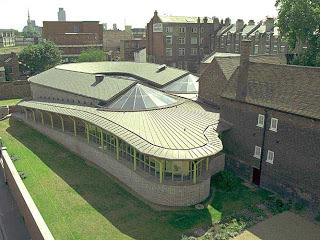
The Branson Coates extension to the Geffrye almshouse, above.
In May of this year, the Heritage Lottery Fund awarded £518,500 to the firm of renowned architect David Chipperfield for a new, major development. The resulting museum will be renamed Museum of the Home. (Surely not! Will they really eliminate the name of the benefactor Geffrye from the museum's name? Methinks it will be along the lines of: The Geffrye, Museum of the Home.)
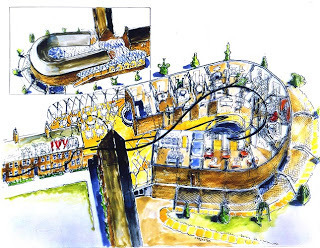 schematic of the design
schematic of the design
According to the Geffrye Museum website: "The total project cost is an estimated £13.2m and is due for completion in April 2015."
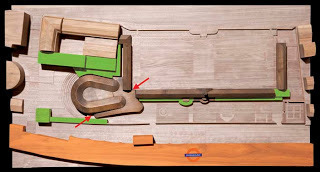
Masterplan by David Chipperfield Architects, 2010
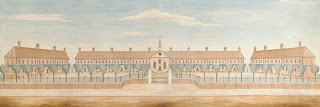 A view of Sir Robert Geffrye's almhouses, 1805
A view of Sir Robert Geffrye's almhouses, 1805
It was apparently owing to influential members of the Arts and Crafts movement in England, circa 1914, that the old almshouses became a museum. One of the main ideas behind it was to honor the local furniture industry in the Shoreditch/Spitalfields area and "to educate and inspire the local workforce". The major consumers of such furniture were London's middle-class, so the period rooms reflect middle-class taste and furniture affordable to them.
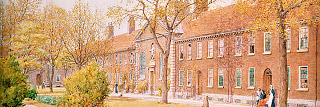
1906 watercolour
According to the Geffrye website: "The museum's collections are presented in the context of period rooms…Their purpose is to show the changing styles and tastes of this urban middle class at different periods of history. They represent living rooms, known in the past as parlours, and later, drawing rooms, and show examples of the furniture, textiles and decorative styles...in a particular period. Clearly there were always a number of designs, colours and patterns to choose from, and these displays can only show a limited selection."
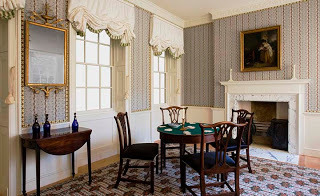 1790 Parlour
1790 Parlour
Again from the Geffrye website: "The use of the parlour remained much the same as earlier in the century… the room where the family … gathered, received guests and taken meals. However, the way it was decorated and furnished had changed considerably. "In diaries, journals and letters of the time people often referred to rooms and furnishings that they liked as 'neat', which meant bright and stylish as well as clean and tidy. This taste required lighter colours and more delicate decoration. Wallpapered walls were particularly useful for achieving this effect, replacing heavily moulded panelling. "In the museum's room the wallpaper is a modern replica copied from a fragment dating to around 1780. The plaster frieze is copied from a house in Cross Street, Islington. Interest in classical design and decoration was increasingly widespread towards the end of the century."Keep in mind that the primary visitors to the Geffrye are school groups. I think that this description is clear but does not make the mistake of talking down to students. The rooms are accessible, the descriptions brief, and every child can surely relate to the concept of a living room.
And the gardens! These are my favorite part of the Geffrye, to be honest. (A word of caution: they are not open all year around, so check before visiting if this is would be an important reason for your visit.) When I first found my way to the Geffrye, there was only this (below). When more funds became available to the museum, period gardens were put in place, and they are brilliant.
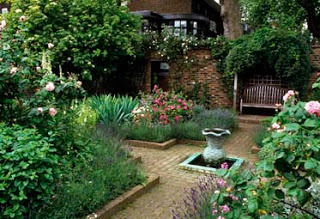 Entering the first (and original) herb garden
Entering the first (and original) herb garden
And here is the 18th Century Period Garden:
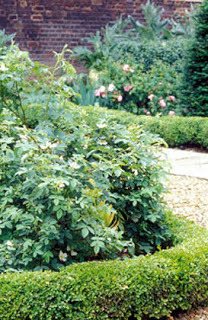
This is rose "De Meux" with a box hedge
"Town gardens were increasingly seen as an extension of the house, a place for recreation and entertainment ... The evidence indicates that the prevailing taste was for simplicity and tidiness, with ornamental gardens featuring paved and/or rolled gravel paths, geometric beds with box edging and the use of evergreen shrubs, often clipped and kept distinct from one another."
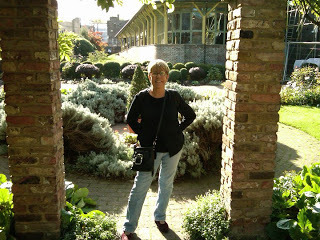 Last year at the Geffrye -- I am in the Period Gardens -- over my left shoulder is the restaurant -- to my right and behind the brick wall, is the brand-new and spiffy Hoxton Station, on the spur line coming from Liverpool Street Station What else is there to do at the Geffrye? And you will have to dedicate at least 2 hours to the galleries and gardens; 3 hours if you decide to have lunch. (Wish they'd post the menus online! It's great English food, the best.)
Last year at the Geffrye -- I am in the Period Gardens -- over my left shoulder is the restaurant -- to my right and behind the brick wall, is the brand-new and spiffy Hoxton Station, on the spur line coming from Liverpool Street Station What else is there to do at the Geffrye? And you will have to dedicate at least 2 hours to the galleries and gardens; 3 hours if you decide to have lunch. (Wish they'd post the menus online! It's great English food, the best.)
Well, there is a very fine shop. (I'd recommend buying the beeswax polish, for starters, great for antique furniture!) Nice ceramics and fun stuff for children like the Regency paper doll. There are inexpensive and handy cutaways of period houses that can be very useful for writers of historical fiction, too. Check here for items made exclusively for the museum.
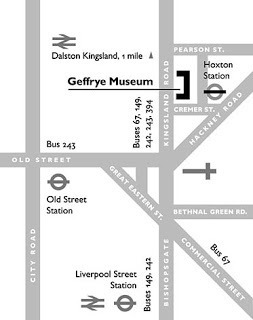
Above is a schematic map showing how to get there from Liverpool Street Station. The Geffrye stop is Hoxton Station. You won't have to walk if you don't want to do so. (Or, you could walk there, through that intriguing old East London area, and return to Liverpool Street by tube…)
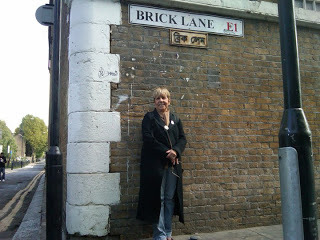
I would also recommend walking around that Liverpool Street area, checking out all the (expensive!) trendy shops and restaurants, and don't forget to take a photo under the famous Brick Lane sign. You'll be happy you did -- Jo
* I assume everyone reading this knows what almshouses were…but, just in case, here is the definition, from the online Cambridge Dictionary:
"A private house built in the past where old or poor people could live without having to pay rent."
It's as good a definition as any, but I would add that both private individuals and local towns, villages, etc., would erect such houses. Their distinctive style of architecture can be seen all over England and many have been converted to senior citizen subsidized housing.

 Geffrye Museum frontage, showing extensive lawns…a serene place of an afternoon to wander about or just to sit on a bench and contemplate life…
Geffrye Museum frontage, showing extensive lawns…a serene place of an afternoon to wander about or just to sit on a bench and contemplate life…Blogger Margarita Lorenzo (her blog is here) writes:
"13 years I have been in London, and never have visited the Geffrye Museum before, that is bad!! considering it is a bus ride away from home, free to visit and about a subject I adore, interiors. [I] decided to venture to East London to discover a bit more about this area and the Museum. The venue is the right size, have gorgeous gardens, entrance, and rooms exploring each period of the English Middle Class houses and their decorations, different styles, ways of living etc. … "
 Main entrance to Geffrey Museum, with statue of Sir Robert Geffrye, who was a Lord Mayor of London and Master of the Ironmongers Company, over the door
Main entrance to Geffrey Museum, with statue of Sir Robert Geffrye, who was a Lord Mayor of London and Master of the Ironmongers Company, over the doorMs. Lorenzo's remarks are what one hears over and over again when the Geffrye Museum is mentioned in conversation… Yes, people have heard the name, but, no, they've never visited, and, gee, it's so accessible using public transportation!
And the exhibitions are always worthwhile. In keeping with the dedicated educational purpose of the Geffrye, there are excellent demonstrations and talks. Their holiday celebrations are not to be missed! (Though be warned that the herb gardens may not be open to the public at that time.) Click here for upcoming events.
So, yes, if one has the time, walk…but take a good map. There are some challenging blocks from the tube station to the Geffrye, many windings and turnings. (And some excellent Vietnamese restaurants, though I'd recommend eating in the brand-new, very nice restaurant at the Geffrye.) This used to be the seat of the furniture trade and a Jewish area. It was also home to Huguenot weavers. The little houses where the weavers lived and wove are now selling in the millions of pounds.

Before lottery money, the Geffrye was these old almshouses bequeathed by a wealthy 17th century London merchant, a charming but rather modest low-key and free museum that was a must on school visit lists. Its raison d'etre was the glimpse of the many rooms, by century and decade, depicting life in London. Since my initial visit some dozen or so years ago, the Geffrye has blossomed. Yes, that lottery money! It enabled the museum to put in more extensive herb gardens (a joy!), expand the educational nature of the museum with gallery space and a large room for crafts and other activities, add additional period rooms, exhibition space, and, last though certainly not least, to install a gorgeous restaurant where once there was only a modest café.
(See wwww.geffryemuseum.org.uk for a virtual tour, or, using the search term Geffryre Museum, click on to Google Images. The new website is amazing!)
Below is a good aerial view of the 1998 extension to the Geffrye. You are seeing the windows of the restaurant that look out onto the new herb gardens. If you could see further, there's a wall and beyond that, the new tube station. The church spire is St Leonard's, I believe, and you can just make out some of the tall office buildings (the famed Gherkin is one of them) in the environs of Liverpool Street. Directly across from the museum is well-maintained council housing. The architectural firm responsible for the extension done in 1998 was Branson Coates Architecture.

The Branson Coates extension to the Geffrye almshouse, above.
In May of this year, the Heritage Lottery Fund awarded £518,500 to the firm of renowned architect David Chipperfield for a new, major development. The resulting museum will be renamed Museum of the Home. (Surely not! Will they really eliminate the name of the benefactor Geffrye from the museum's name? Methinks it will be along the lines of: The Geffrye, Museum of the Home.)
 schematic of the design
schematic of the designAccording to the Geffrye Museum website: "The total project cost is an estimated £13.2m and is due for completion in April 2015."

Masterplan by David Chipperfield Architects, 2010
 A view of Sir Robert Geffrye's almhouses, 1805
A view of Sir Robert Geffrye's almhouses, 1805It was apparently owing to influential members of the Arts and Crafts movement in England, circa 1914, that the old almshouses became a museum. One of the main ideas behind it was to honor the local furniture industry in the Shoreditch/Spitalfields area and "to educate and inspire the local workforce". The major consumers of such furniture were London's middle-class, so the period rooms reflect middle-class taste and furniture affordable to them.

1906 watercolour
According to the Geffrye website: "The museum's collections are presented in the context of period rooms…Their purpose is to show the changing styles and tastes of this urban middle class at different periods of history. They represent living rooms, known in the past as parlours, and later, drawing rooms, and show examples of the furniture, textiles and decorative styles...in a particular period. Clearly there were always a number of designs, colours and patterns to choose from, and these displays can only show a limited selection."
 1790 Parlour
1790 ParlourAgain from the Geffrye website: "The use of the parlour remained much the same as earlier in the century… the room where the family … gathered, received guests and taken meals. However, the way it was decorated and furnished had changed considerably. "In diaries, journals and letters of the time people often referred to rooms and furnishings that they liked as 'neat', which meant bright and stylish as well as clean and tidy. This taste required lighter colours and more delicate decoration. Wallpapered walls were particularly useful for achieving this effect, replacing heavily moulded panelling. "In the museum's room the wallpaper is a modern replica copied from a fragment dating to around 1780. The plaster frieze is copied from a house in Cross Street, Islington. Interest in classical design and decoration was increasingly widespread towards the end of the century."Keep in mind that the primary visitors to the Geffrye are school groups. I think that this description is clear but does not make the mistake of talking down to students. The rooms are accessible, the descriptions brief, and every child can surely relate to the concept of a living room.
And the gardens! These are my favorite part of the Geffrye, to be honest. (A word of caution: they are not open all year around, so check before visiting if this is would be an important reason for your visit.) When I first found my way to the Geffrye, there was only this (below). When more funds became available to the museum, period gardens were put in place, and they are brilliant.
 Entering the first (and original) herb garden
Entering the first (and original) herb gardenAnd here is the 18th Century Period Garden:

This is rose "De Meux" with a box hedge
"Town gardens were increasingly seen as an extension of the house, a place for recreation and entertainment ... The evidence indicates that the prevailing taste was for simplicity and tidiness, with ornamental gardens featuring paved and/or rolled gravel paths, geometric beds with box edging and the use of evergreen shrubs, often clipped and kept distinct from one another."
 Last year at the Geffrye -- I am in the Period Gardens -- over my left shoulder is the restaurant -- to my right and behind the brick wall, is the brand-new and spiffy Hoxton Station, on the spur line coming from Liverpool Street Station What else is there to do at the Geffrye? And you will have to dedicate at least 2 hours to the galleries and gardens; 3 hours if you decide to have lunch. (Wish they'd post the menus online! It's great English food, the best.)
Last year at the Geffrye -- I am in the Period Gardens -- over my left shoulder is the restaurant -- to my right and behind the brick wall, is the brand-new and spiffy Hoxton Station, on the spur line coming from Liverpool Street Station What else is there to do at the Geffrye? And you will have to dedicate at least 2 hours to the galleries and gardens; 3 hours if you decide to have lunch. (Wish they'd post the menus online! It's great English food, the best.)Well, there is a very fine shop. (I'd recommend buying the beeswax polish, for starters, great for antique furniture!) Nice ceramics and fun stuff for children like the Regency paper doll. There are inexpensive and handy cutaways of period houses that can be very useful for writers of historical fiction, too. Check here for items made exclusively for the museum.

Above is a schematic map showing how to get there from Liverpool Street Station. The Geffrye stop is Hoxton Station. You won't have to walk if you don't want to do so. (Or, you could walk there, through that intriguing old East London area, and return to Liverpool Street by tube…)

I would also recommend walking around that Liverpool Street area, checking out all the (expensive!) trendy shops and restaurants, and don't forget to take a photo under the famous Brick Lane sign. You'll be happy you did -- Jo
* I assume everyone reading this knows what almshouses were…but, just in case, here is the definition, from the online Cambridge Dictionary:
"A private house built in the past where old or poor people could live without having to pay rent."
It's as good a definition as any, but I would add that both private individuals and local towns, villages, etc., would erect such houses. Their distinctive style of architecture can be seen all over England and many have been converted to senior citizen subsidized housing.
Published on September 10, 2011 01:00
September 9, 2011
Travels with Victoria: The Windsor Museum
I was delighted to spend my last full day in England, June 15, 2011, with Hester Davenport in Windsor.Here is Hester with members of the Irish guard with their canine mascot at the opening of the museum.
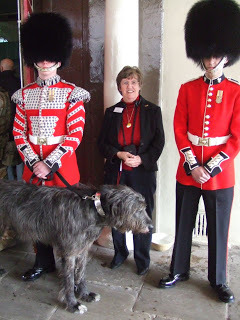
Hester generously planned our day beginning by meeting me at the train station in Slough, pronounced I believe to rhyme with plow (or plough). Our first stop was a new park, formed from an old one which had fallen into disrepair.
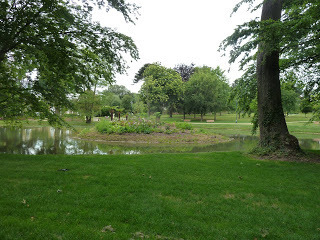 The Herschel Park, 2011
The Herschel Park, 2011
The park is named after the famed German-born astronomer and musician-composer Sir Frederick Herschel (1738-1822) who died in Slough after a distinguished career in which he discovered the planet Uranus and its moons, invented a number of telescopes, named the "asteroids", and composed more than twenty symphonies. His sister Caroline was a significant partner in many of his scientific studies.
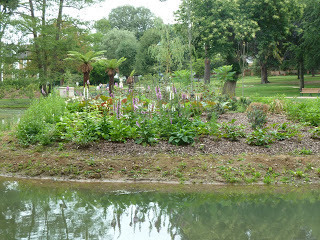
In the mid-nineteenth century, this area was part of a housing development which included large open spaces, and was known as Upton Park. It borders the M-4 and most of it was badly in need of renewal when a group, with money partially from the Heritage Lottery Fund, redesigned the park with nature trails and a Victorian band shell, a real asset for the neighborhood.Below, an old view of the Victorian park.
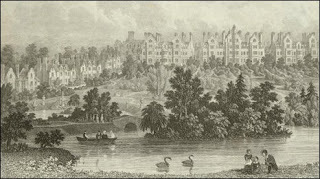
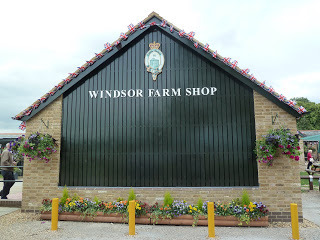
Our next stop was the Windsor Farm Shop where one can buy the Queen's own beef, poultry and vegetables, straight from the Royal Estates. The goods were very enticing, I must say.
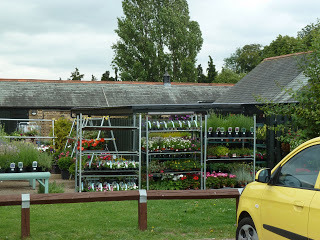
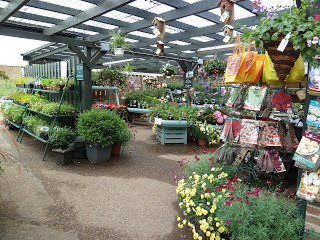
Outside, there was a wide array of herbs, vegetables and flowers for one's own gardens. But I couldn't quite figure out how I would get them home across the pond!
After a quick sandwich, we walked over to the Windsor Great Park to see the Queen and the royal family pass by on their way to the Ascot Races. I completely failed to get a photo here, but I found one in a newspaper that shows the Queen in what I believe is her loveliest hat. We got a very good glimpse of her and I was so impressed, I forgot my camera altogether. Isn't this the prettiest chapeau EVER?
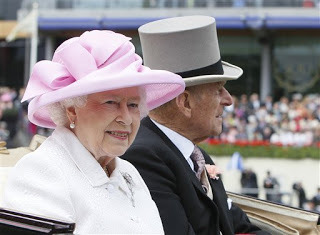
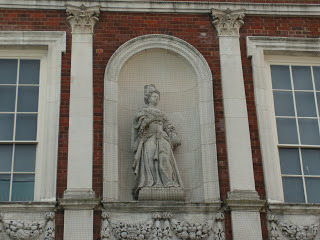
Above, Queen Anne on the Windsor Guildhall, home of the new museum.
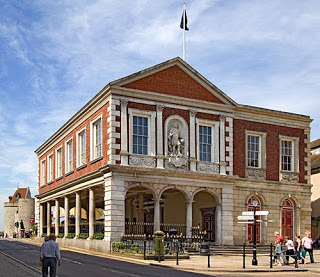 View of the Guildhall from the south, showing the original Wren building completed in 1689 and the extension at the rear, constructed about 1829.
View of the Guildhall from the south, showing the original Wren building completed in 1689 and the extension at the rear, constructed about 1829.
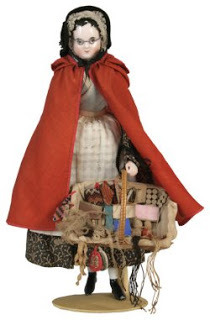 In March of 2011, the Windsor and Royal Borough Museum opened on the ground floor of the Guildhall. The doll above is one of thousands of artifacts to be exhibited, covering prehistoric to recent days.
In March of 2011, the Windsor and Royal Borough Museum opened on the ground floor of the Guildhall. The doll above is one of thousands of artifacts to be exhibited, covering prehistoric to recent days.
Hester Davenport blogged here about some of the most fascinating items in the collection, the miniature dioramas created in the 1950's by Judith Ackland and Mary Stella Edwards. Below, a detail of Windsor during George II's Golden Jubilee in 1809, showing the princesses dancing at the local celebration.
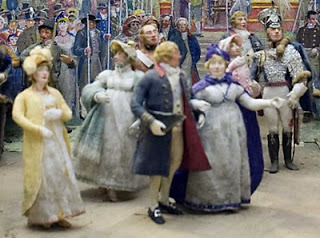 Since the town council was not in session, I had the opportunity to go upstairs and view the council chamber, the mayor's office and the Ascot Room up close.
Since the town council was not in session, I had the opportunity to go upstairs and view the council chamber, the mayor's office and the Ascot Room up close.
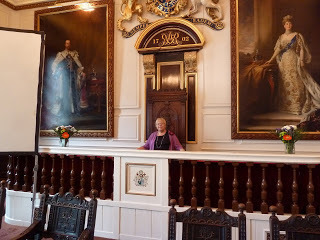 You will be pleased to know that I did not dissolve the town while I sat in the mayor's chair under the portraits of Edward VII and Queen Alexandra.
You will be pleased to know that I did not dissolve the town while I sat in the mayor's chair under the portraits of Edward VII and Queen Alexandra.
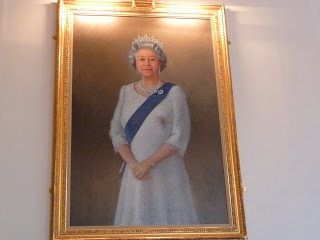 This recent picture of Queen Elizabeth II hangs in the Council Chamber, but I have to admit I preferred the earlier one below, which is not currently hanging but can be seen in the Ascot Room underneath a portrait of Queen Victoria, her great-great grandmother.
This recent picture of Queen Elizabeth II hangs in the Council Chamber, but I have to admit I preferred the earlier one below, which is not currently hanging but can be seen in the Ascot Room underneath a portrait of Queen Victoria, her great-great grandmother.
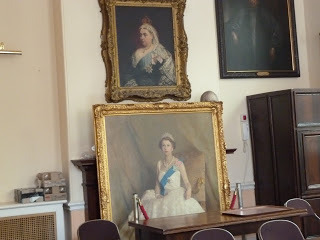
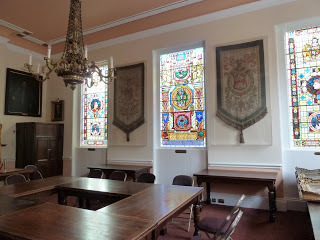 The Ascot Room, next to the Council Chamber, is often used for wedding ceremonies, most notably the 2005 marriage of Prince Charles and Camilla Parker Bowles, and later that year, the civil partnership of Sir Elton John and David Furnish.
The Ascot Room, next to the Council Chamber, is often used for wedding ceremonies, most notably the 2005 marriage of Prince Charles and Camilla Parker Bowles, and later that year, the civil partnership of Sir Elton John and David Furnish.
Hester and I finished with a delicious dinner. I thank her ever so much for showing my around. Hester is a very busy lady, with many boards and committees having to do with local history and the 18th /19th C. history. She is currently, for example, the chariman of The Burney Society and is a frequent speaker and writer on literary figures. Thank you, Hester!!!
The next day I was off to Heathrow for the return trip, already planning for my next visit.
Travels with Victoria for 2011 concludes with this post. I hope you have enjoyed vicariously accompanying me on my jaunts. And I hope you did not catch my pesky cold -- which followed me back home but is now, thankfully, only a memory.

Hester generously planned our day beginning by meeting me at the train station in Slough, pronounced I believe to rhyme with plow (or plough). Our first stop was a new park, formed from an old one which had fallen into disrepair.
 The Herschel Park, 2011
The Herschel Park, 2011The park is named after the famed German-born astronomer and musician-composer Sir Frederick Herschel (1738-1822) who died in Slough after a distinguished career in which he discovered the planet Uranus and its moons, invented a number of telescopes, named the "asteroids", and composed more than twenty symphonies. His sister Caroline was a significant partner in many of his scientific studies.

In the mid-nineteenth century, this area was part of a housing development which included large open spaces, and was known as Upton Park. It borders the M-4 and most of it was badly in need of renewal when a group, with money partially from the Heritage Lottery Fund, redesigned the park with nature trails and a Victorian band shell, a real asset for the neighborhood.Below, an old view of the Victorian park.


Our next stop was the Windsor Farm Shop where one can buy the Queen's own beef, poultry and vegetables, straight from the Royal Estates. The goods were very enticing, I must say.


Outside, there was a wide array of herbs, vegetables and flowers for one's own gardens. But I couldn't quite figure out how I would get them home across the pond!
After a quick sandwich, we walked over to the Windsor Great Park to see the Queen and the royal family pass by on their way to the Ascot Races. I completely failed to get a photo here, but I found one in a newspaper that shows the Queen in what I believe is her loveliest hat. We got a very good glimpse of her and I was so impressed, I forgot my camera altogether. Isn't this the prettiest chapeau EVER?


Above, Queen Anne on the Windsor Guildhall, home of the new museum.
 View of the Guildhall from the south, showing the original Wren building completed in 1689 and the extension at the rear, constructed about 1829.
View of the Guildhall from the south, showing the original Wren building completed in 1689 and the extension at the rear, constructed about 1829. In March of 2011, the Windsor and Royal Borough Museum opened on the ground floor of the Guildhall. The doll above is one of thousands of artifacts to be exhibited, covering prehistoric to recent days.
In March of 2011, the Windsor and Royal Borough Museum opened on the ground floor of the Guildhall. The doll above is one of thousands of artifacts to be exhibited, covering prehistoric to recent days.Hester Davenport blogged here about some of the most fascinating items in the collection, the miniature dioramas created in the 1950's by Judith Ackland and Mary Stella Edwards. Below, a detail of Windsor during George II's Golden Jubilee in 1809, showing the princesses dancing at the local celebration.
 Since the town council was not in session, I had the opportunity to go upstairs and view the council chamber, the mayor's office and the Ascot Room up close.
Since the town council was not in session, I had the opportunity to go upstairs and view the council chamber, the mayor's office and the Ascot Room up close. You will be pleased to know that I did not dissolve the town while I sat in the mayor's chair under the portraits of Edward VII and Queen Alexandra.
You will be pleased to know that I did not dissolve the town while I sat in the mayor's chair under the portraits of Edward VII and Queen Alexandra. This recent picture of Queen Elizabeth II hangs in the Council Chamber, but I have to admit I preferred the earlier one below, which is not currently hanging but can be seen in the Ascot Room underneath a portrait of Queen Victoria, her great-great grandmother.
This recent picture of Queen Elizabeth II hangs in the Council Chamber, but I have to admit I preferred the earlier one below, which is not currently hanging but can be seen in the Ascot Room underneath a portrait of Queen Victoria, her great-great grandmother.
 The Ascot Room, next to the Council Chamber, is often used for wedding ceremonies, most notably the 2005 marriage of Prince Charles and Camilla Parker Bowles, and later that year, the civil partnership of Sir Elton John and David Furnish.
The Ascot Room, next to the Council Chamber, is often used for wedding ceremonies, most notably the 2005 marriage of Prince Charles and Camilla Parker Bowles, and later that year, the civil partnership of Sir Elton John and David Furnish.Hester and I finished with a delicious dinner. I thank her ever so much for showing my around. Hester is a very busy lady, with many boards and committees having to do with local history and the 18th /19th C. history. She is currently, for example, the chariman of The Burney Society and is a frequent speaker and writer on literary figures. Thank you, Hester!!!
The next day I was off to Heathrow for the return trip, already planning for my next visit.
Travels with Victoria for 2011 concludes with this post. I hope you have enjoyed vicariously accompanying me on my jaunts. And I hope you did not catch my pesky cold -- which followed me back home but is now, thankfully, only a memory.
Published on September 09, 2011 02:00
September 7, 2011
Travels with Victoria: British Museum, Part Two
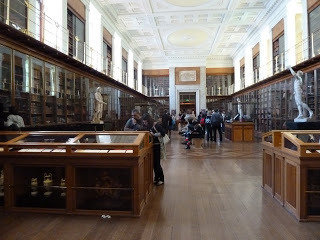
The King's Library in the British Museum has a new function. The oldest room in the museum, it was built in 1827 to house the collection of books amassed by King George III. This collection of 60,000 volumes was moved to the new British Library, St. Pancras, in 1997.
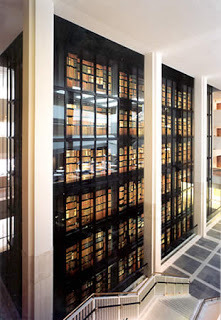 In the British Library
In the British LibraryGeorge IV donated his father's book collection to the British people in 1823, necessitating a new building on the site of the original British Museum in Montagu House, Bloomsbury, one of many expansions and re-modelings over the years. Since George III's book collection was moved a few years ago, the King's Library Gallery has been restored, conserved and adapted for a new purpose: a permanent exhibition devoted to The Enlightenment.
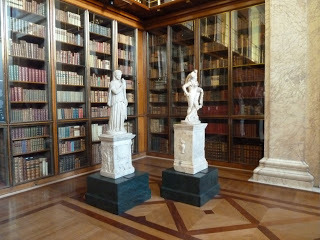 ancient statues in front of cases filled with books on loan from the House of Commons Library
ancient statues in front of cases filled with books on loan from the House of Commons LibraryFrom the introduction to the exhibition: "The Enlightenment is the name given to the age of reason, discovery and learning that flourished from about 1680 to 1820 and changed the way that people viewed the world. Enlightened men and women believed that the key to unlocking the past and the mysteries of the universe lay in directly observing and studying the natural and the man-made world. Their passion for collecting objects, from fossils and flints to Greek vases and ancient scripts, was matched by their desire to impose order on them, to catalogue and to classify."
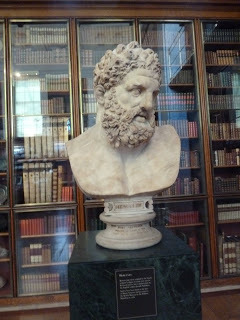 Bust of Hercules: Roman copy of original by Greek sculptor Lysippos,said to have been found at the foot of Mount Vesuvius andpresented to the British Museum by Sir William Hamilton in 1776.
Bust of Hercules: Roman copy of original by Greek sculptor Lysippos,said to have been found at the foot of Mount Vesuvius andpresented to the British Museum by Sir William Hamilton in 1776. Continuing with the introduction: "The objects displayed in this room were collected during the early years of the British Museum, which was founded in 1753. They help us explore the passions and ideas of collectors and scholars at this time. When the British Museum was founded, it was a place not only of learning but also of wonder. This gallery focuses on the Museum's early collectors, recreating that first sense of amazement and exploring some of the ways that people in Britain viewed their world and its past."
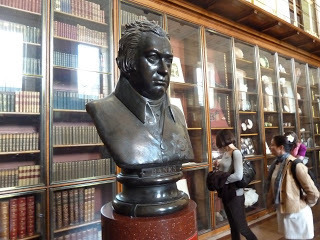 Sir Joseph Banks, 1743-1820, Botanist, Trustee and benefactor of the British Museum; bust by the Hon. Anne Seymour Damer, 1813.
Sir Joseph Banks, 1743-1820, Botanist, Trustee and benefactor of the British Museum; bust by the Hon. Anne Seymour Damer, 1813. 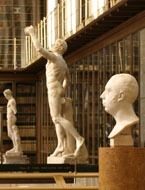
After spending quite a bit of time wandering in this fascinating room -- much larger than it appears in these pictures -- I decided to take another quick look at some of the other British Museums earliest treasures.
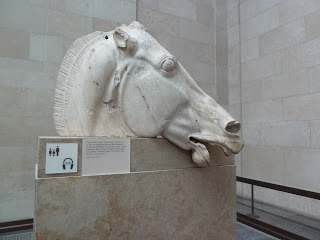
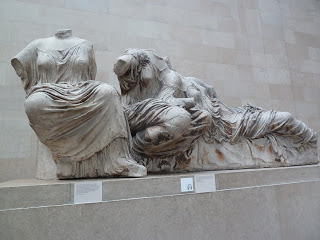
The Elgin Marbles were collected by the 7th Earl of Elgin from the ruins of the Parthenon in Athens between 1799 and 1812. He had them shipped to London and after considerable Parliamentary controversy, the nation purchased them and placed them in the British Museum in 1816. It's a long, convoluted story, interesting on many levels from the personal travails of Lord and Lady Elgin to the continuing arguments over their ownership. I don't have the time or space to condense any of these stories at the moment. I just enjoyed joining the hundreds of people studying the brilliant examples of ancient sculpture.
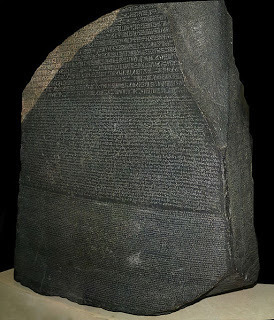
The Rosetta Stone was taken from its original location in Egypt by French troops in 1799; British troops defeated the French and took the stone in 1801. It was brought to London and has been in the British Museum since 1802. On the surface of the stone, a government decree is inscribed in three languages: ancient Egyptian hieroglyphics, demotic script and ancient Greek. Thus it was possible to translate and read hieroglyphs for the first time. Though almost all the above photographs are mine, I literally could not get close enough to the Rosetta Stone to take a photo on Sunday, June 12, 2011. There were constant crowds around it, exclaiming in a multitude of languages about this great treasure of civilization -- I thought that was a good thing!!
And now, another of those absurd wrenches from the sublime to the ridiculous. Having had enough exploring in the British Museum, I started walking back to my hotel. When what should appear but another version of the world naked bike ride. In June of 2010, Kristine and I were surprised to stand in the doorway of Apsley House in front of a street full of hundreds of nude riders. All we could do was wonder what the 1st Duke of Wellington would have thought?
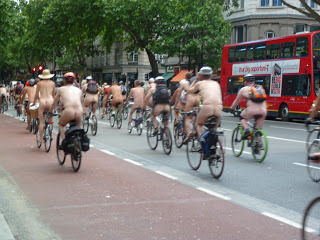
And here I was, almost a year to the day later, again confronted by the same spectacle. This time, however, I had my camera handy. The most amusing part of it was to watch the reactions of drivers, bus riders and passers-by as the huge number of bikes (accompanied by a police escort) rode down Kingsway. Believe me, dear readers, it was not easy to take a non-X-rated snapshot. I assume that these riders -- who can be found in similar events around the world -- have a mission of some kind. But for me, it was again such a peculiar juxtaposition of the enlightenment and "not a pretty sight" that the point of it all (so to speak) was lost on me.
But it is certainly another confirmation of the idea that in London, you can find a little of almost everything! And maybe even too much of some things?

The last stop on Travels with Victoria will be Windsor, where I had a lovely day's visit with Hester Davenport, coming soon.
Published on September 07, 2011 02:00
September 5, 2011
A Letter Concerning the Origin of Sir Walter Scott's "Bride of Lammermoor"
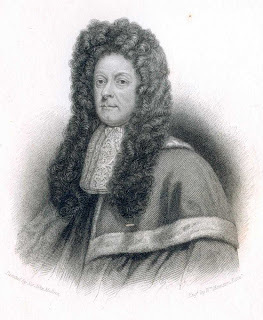
Viscount Stair
From Sir James Stuart Dalrymple Elphinstone to Sir John Shelley
September 5, 1823.
My Dear Sir John,
"... The bride of Baldoon (for such has always been her designation in our family) was the Hon. Janet Dalrymple, eldest daughter of our greatgreat-grandfather James, Viscount Stair, who was Lord President of the Court of Session in the reign of William and Mary. Janet Dalrymple was sister to the first Earl of Stair, and to our great-grandfather, the Lord President Sir Hugh Dalrymple of North Berwick. She was therefore our great-grand-aunt.
"Janet Dalrymple was deeply attached to Lord Rutherford, to whom she had plighted her troth unknown to her parents. Under the auspices of her mother, a less amiable but far richer suitor appeared in the person of David Dunbar, eldest son of Sir David Dunbar of Baldoon. It was in vain that the young lady not only showed her aversion to his addresses, but also told David Dunbar of her attachment to another, and of the solemn engagement she had made. The new suitor was warmly supported by Janet's mother, and would take no refusal. In these circumstances the poor girl was forced into a marriage which she cordially detested.
"The result of this cruel and unnatural sacrifice was nearly, if not exactly, as related by Sir Walter Scott. On the marriage night, soon after the young couple had been left alone, violent and continuous screams were heard proceeding from the bridal chamber. The door was found to be locked, and, upon being forced open, the bridegroom was found lying on the floor, stabbed and weltering in his blood. In the corner of the large fireplace sat the bride in a state of uncontrollable phrensy. This condition of mind continued, without intermission, until the hour of her death. She did not long survive, and with the exception of the few words, 'Ye hae taen up your bonnie bridegroom,' mentioned by Sir Walter Scott, she never spoke again.
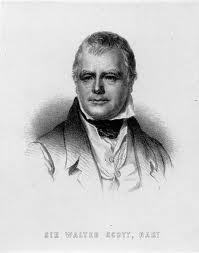
Sir Walter Scott
"The natural conclusion drawn from these tragic events—a conclusion which seems to have been assumed by Sir Walter—was that the unhappy and distracted victim, seeing no other means of escape from a fate which she held in abhorrence, had in a fit of desperation inflicted the fatal wound upon her selfish and unfeeling husband. But in justice to the memory of our unhappy relative we may be permitted to regret that Sir Walter Scott had not been informed of a tradition long current in that part of the country where this tragic event took place. From the circumstance that the window of the bridal chamber had been found wide open it is conjectured that her lover, Lord Rutherford, had during the bustle and confusion incidental to the preparation of the marriage feast— perhaps with the connivance of some servant—contrived to conceal himself in the bridal chamber. That he had fought with and severely wounded his rival, and had escaped through the window which overlooked the garden.
"This is the more probable owing to the fact that young Baldoon—to the last moment of his life— absolutely refused to make any statement whatever. It is more than probable that he was actuated by a desire to conceal the particulars of a rencontre the cause and consequence of which he might well consider as discreditable to himself.
"Lord Rutherford is said to have disappeared immediately after the event took place in a mysterious manner; but that part of the story has escaped my recollection.
"While on this subject I cannot help offering some observations relative to the principal characters introduced in 'The Bride of Lammermoor.' They are all more or less interesting to us both.
"The portrait of Sir William Ashton cannot be regarded as a fair representation of our eminent ancestor, Lord Stair, to whom he bears little resemblance. Sir Walter would seem wishful to avoid any comparison between them when he says that, on acquiring the ancient seat of the Lords of Ravenswood, Sir William had removed certain old family portraits and replaced them by those of King William and Queen Mary, and of Sir Thomas Hope and Lord Stair. . . . Having in the character of Lucy Ashton so closely delineated that of the daughter, the author should, in fairness, have been at more pains to prevent the description of the Lord Keeper from being regarded as an equally fair representation of the father. This is an omission of which the descendants of Lord Stair have, I think, some reason to complain.
"In Lady Ashton the portrait of our ancestress seems to be more faithfully drawn, or at least less misrepresented. She was an ambitious and designing woman, of a masculine character and understanding. It was her fixed determination that her daughter should make that fatal marriage.
"The description of young Ravenswood bears a marked resemblance to that of Lord Rutherford, who was an amiable and high-spirited young man, nobly born, but destitute of fortune. He was certainly well cut out for a hero of romance.
"As to young Baldoon, of whom very little is known, beyond what I have already stated, he seems to have cut a better figure than he deserved in the person of' Bucklaw.' . . .
"So far as Sir Walter Scott's information went— beyond changing the scene of action from the west coast to the east—he seems to have kept to facts as closely as was consistent with a work of fiction. But, if a record of a distressing family incident was to be handed down to posterity in a manner so affecting, and by so renowned an author, it would have been well if the author of' The Bride of Lammermoor' had been made acquainted with a tradition which puts quite a different complexion on the affair.
"I am of opinion that with judicious management the interest of the story would have been increased, and would certainly have left a less painful impression regarding our unhappy and unfortunate relative, the Bride of Baldoon.
"With best regards from all here to you and Lady Shelley, I remain, my dear Sir John,
Ever most truly yours,
James Dalrymple Elphinstone
Published on September 05, 2011 00:43
Kristine Hughes's Blog
- Kristine Hughes's profile
- 6 followers
Kristine Hughes isn't a Goodreads Author
(yet),
but they
do have a blog,
so here are some recent posts imported from
their feed.



